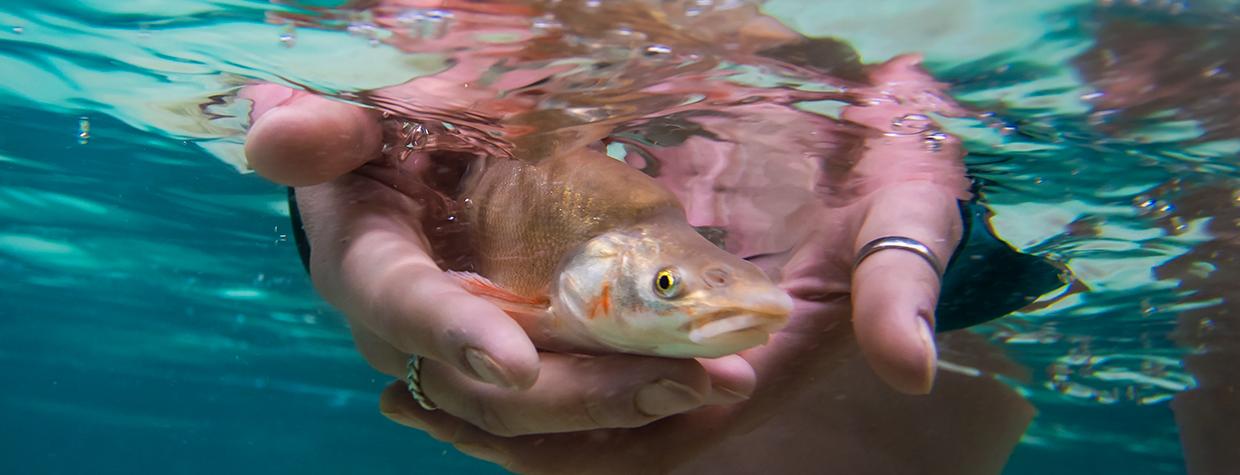When Grand Canyon prospector Ben Beamer traveled to Denver in July 1892, it was big news. The Denver Republican interviewed him about his hermit-like existence at the bottom of the Canyon, where he lived in a rock shelter near the confluence of the Colorado and Little Colorado rivers.
The newspaper, amazed that Beamer was able to survive in such a rugged landscape, asked: What did he eat? “I get plenty of fish,” the crusty prospector replied. Beamer described how in spring, there were “millions” of fish at the confluence. They were strange-looking creatures, he said, with humps on their backs. And they were far more plentiful than the precious minerals Beamer was seeking to uncover. “They are so thick that you can lean over the water’s edge and pull them out by the tail two at a time,” Beamer reported, perhaps exaggerating a bit.
Beamer likely was describing the humpback chub, which biologists would formally identify four decades later as a species found nowhere except the Colorado River and its tributaries. Once Grand Canyon National Park was established in 1919, scientists began taking a closer look at how various endemic species, such as the humpback chub, had evolved to withstand the Canyon’s harsh environment.
The humpback chub’s eyes are designed to see clearly in the Colorado’s sediment-laden waters. Its gills and mouth have protective flaps to filter the muddy river. And large fins help the chub navigate river flows that once fluctuated wildly — from 100,000 cubic feet per second during spring floods to 1,000 cfs during periods of drought.
A member of the minnow family, the humpback chub can grow to 20 inches long and live for 30 years in the wild. The exquisitely designed creature, along with seven other native fish species, thrived in the unruly Colorado River for millions of years. But in 1963, the floodgates on the newly constructed Glen Canyon Dam closed and the river through the Canyon became more like a Montana trout stream: cold, clear and suddenly inhospitable for native fish.
The possibility of human development obliterating one of the Canyon’s emblematic species caused the humpback chub to be added to the federal endangered species list in 1973, the same year the landmark Endangered Species Act was passed. Over the next few decades, teams of scientists swooped in with programs to push back against the altered environment created by the dam. And it appeared the efforts were working. Recently, though, human-caused conditions have threatened to once again drastically alter the Canyon’s environment.
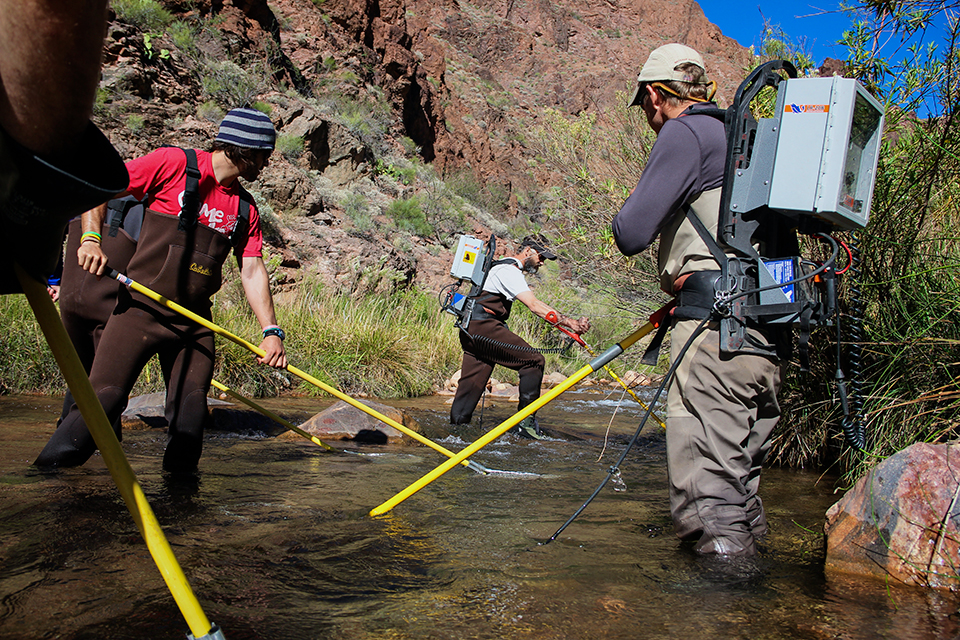
Unfortunately for the humpback chub and the Canyon’s four other surviving native fish species, their destinies are now tied up in a much larger debate about water in the West and the management of a diminished Lake Powell during an era of climate change. But the scrappy Canyon-adapted fish are highly experienced survivalists — and their tireless human protectors are as inherently optimistic as a 19th century gold digger.
When Arizona Game and Fish Department biologist Scott Rogers joined the agency in 1993 as a research biologist in the Canyon, the humpback chub was the Canyon’s iconic endangered fish. Lake Powell, behind Glen Canyon Dam, was full, and the water released from the bottom of the dam was about 50 degrees year-round. The conditions were ideal for the non-native rainbow trout stocked (and later established) at Lees Ferry, just downstream from the dam, but not for the humpback chub farther downstream.
The Canyon’s largest and last reproducing population of humpback chub spawned in the Little Colorado River — upstream from the confluence where, a century earlier, Beamer had allegedly pulled the plentiful fish out of the water with his hands. The chub, which once had been plentiful in the Canyon, had dwindled to 2,000 to 5,000 in the 1990s. Three other endemic native fish species — the Colorado pikeminnow, bonytail chub and roundtail chub — had been extirpated from the Canyon because of changes in habitat. (These fish remain present in places outside the Canyon.)
“The water was so cold, the chub couldn’t grow in the river’s main channel,” says Rogers, who now is Game and Fish’s regional fisheries program manager in Northern Arizona. Temperatures were higher in the Little Colorado, and the humpback chub managed to survive by swimming up the tributary to spawn. But predation of the chub by non-native fish was implicated in the population decline, too.
Game and Fish, along with federal partners, started implementing strategies to conserve what was left of the Canyon’s native fish while not compromising the trout fishery at Lees Ferry. Between 2003 and 2006, the U.S. Geological Survey, in partnership with Game and Fish, carried out a non-native-fish removal program around the confluence. Over three years, more than 23,000 rainbow and brown trout were mechanically shocked, plucked from the water and euthanized.
Surveys conducted after the program showed that trout numbers in the area were reduced by approximately 90 percent while humpback chub and other native fish populations increased. “Over the years, we realized it was possible to manage the rainbow trout within the Lees Ferry reach and also have successful native fish populations downstream,” Rogers says.
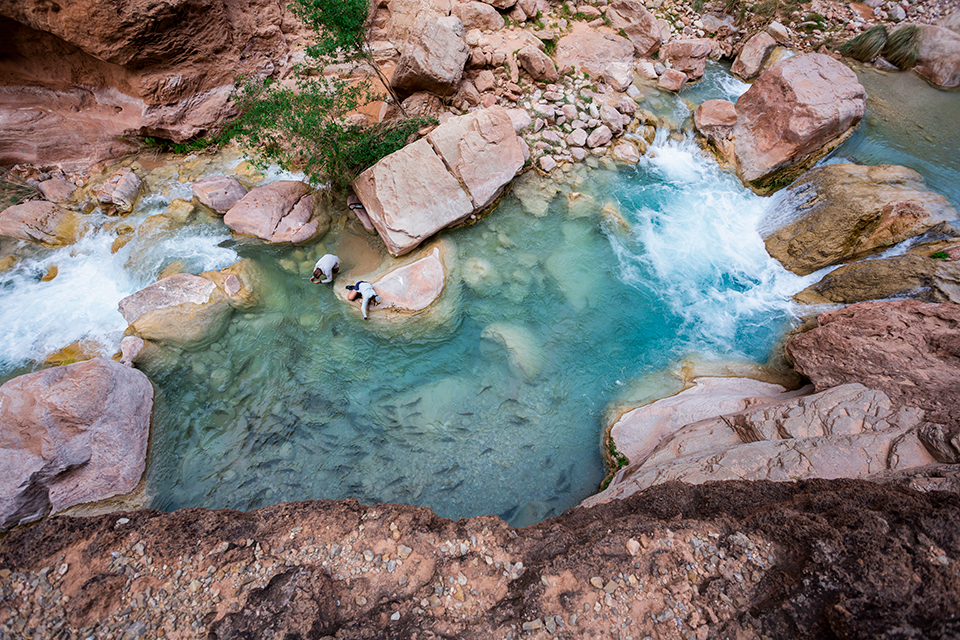
For scientists who’ve devoted much of their careers to saving the humpback chub, efforts to boost population numbers have been encouraging. Rogers also notes that, concurrent with the removal program, Lake Powell’s water level dropped to less than one-third of its capacity over the past two decades, causing water released from the dam to warm significantly. For a time, the water was warm enough for chub to thrive downstream, in the western Grand Canyon, but not warm enough for non-native, warm-water fish to establish a population.
It was a surprising reversal of fortune for native fish. But troubles for the chub were far from over. Recently, even lower lake levels have led to even warmer water being released from the dam — in September 2022, for example, the Colorado was a record 70 degrees in the Canyon. Now, warm-water species such as smallmouth bass, a ubiquitous sport fish and voracious predator of native river fish, are threatening to wipe out two decades of recovery. These non-native species are already responsible for significantly reducing humpback chub populations in the Colorado’s upper basin, upstream from Lake Powell.
Ironically, the 710-foot-tall dam protected the Canyon’s native fish from these predators for some 50 years. During that time, the reservoir was higher and water releases were coming from well below the surface layer, where the bass reside. But with the reservoir’s water level now barely above that needed for hydropower generation, Lake Powell’s non-native, warm-water fish can travel downstream. The result, Rogers says, is “definitely the largest risk I’ve seen to Grand Canyon’s native fish in over 30 years.”
In July 2022, when biologists found smallmouth bass living in the Colorado just above the Canyon, it was the ecological equivalent of a five-alarm fire. The species is likely on the move, and scientists say if the bass become established in the Canyon, they’ll be very difficult to remove.
“There are legal reasons, under the Endangered Species Act, to do everything we can to protect the humpback chub,” Rogers says. But there are moral reasons as well, he adds: “These native fish are part of our heritage, and we must protect them for future generations.”
The question is how to protect the fish in the face of daunting circumstances around climate change and Western water politics — and whether it can be done before it’s too late.
Like Rogers, Emily Omana Smith has dedicated her career to protecting the Canyon’s native fish. She’s the fisheries program manager for Grand Canyon National Park and has been involved in native fish recovery programs since 2007. She likens the quest to save the park’s fish to flying a plane with its rivets popping out.
“We have already lost three rivets,” she says, referring to the three native fish species that can no longer be found in the Canyon. In addition to the humpback chub, the four other native fish species still hanging on in the Canyon are the razorback sucker, bluehead sucker, flannelmouth sucker and speckled dace.
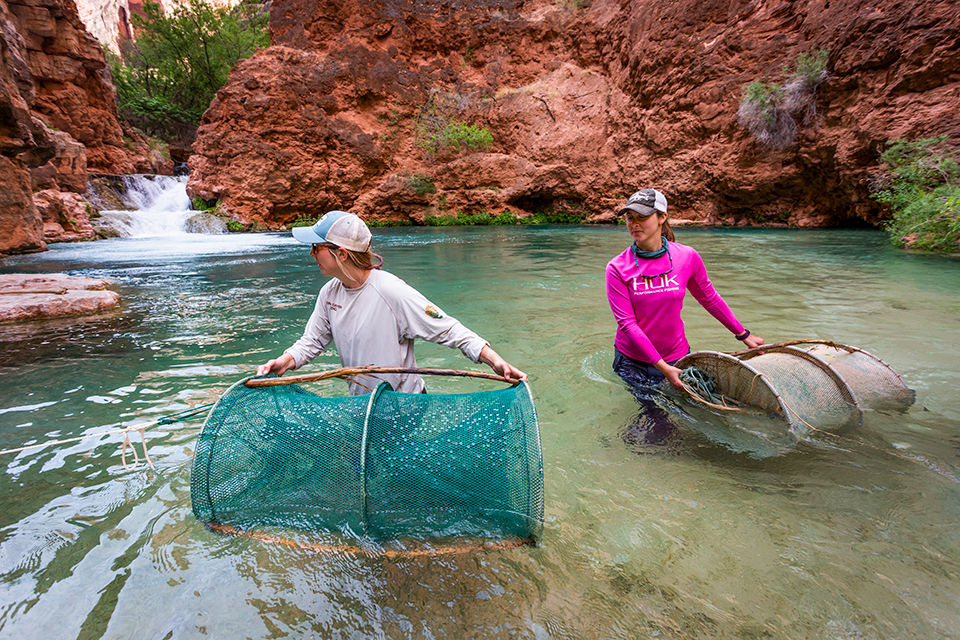
“We know a lot more about ecosystems now than when Grand Canyon National Park was created and trout were being stocked in every stream,” Omana Smith says. “We know everything is connected and relies on a fully functioning ecosystem. How many rivets can you lose before the plane crashes?”
To try to keep the plane in the air, the park has been operating a fisheries conservation program since 2009. Fisheries program staff have mechanically removed trout from Bright Angel Creek and translocated humpback chub in tributaries where the water is warm, food is abundant and trout are scarce.
One of the most successful of these projects is along Havasu Creek, the home of the Havasupai people. It began in 2010 with the translocation of 243 juvenile chub from the Little Colorado River to the tributary. The elaborate process involved netting the chub in the Little Colorado and flying them by helicopter to a U.S. Fish and Wildlife Service hatchery where they could mature over the winter and be conditioned for swift river swimming. They were flown back to the Canyon, tagged and released in Havasu Creek the following year. In 2013, biologists found baby humpback chub in the creek, indicating that the long-shot goal of creating a successful spawning population had been achieved.
“It was an amazing moment when we caught the first untagged young-of-the-year chub in Havasu Creek,” says Amy S. Martin, a photographer — she’s a longtime contributor to Arizona Highways — and a fisheries technician for the park. “It meant that after all the effort, baby chub were being born and were viable.” Martin, who’s worked with the fisheries program since 2011, says the chub in Havasu are now “thriving.”
Like Lake Powell, Lake Mead, below the Canyon, has shrunk dramatically and created miles of recovered river habitat for native fish. Omana Smith says the humpback chub is now one of the dominant fish species in the western Grand Canyon after being almost nonexistent in the area a decade ago. And, notably, the chub are living in the main channel of the Colorado, rather than seeking sanctuary in tributaries.
“Things are at a high point right now and better than we could have ever imagined,” Omana Smith says of the chub’s recovery in the Canyon. But she notes that the trend could reverse quickly, as it has elsewhere, due to the smallmouth bass threat.
Omana Smith says it’s critical to be proactive, partly because there are no proven mechanisms for controlling smallmouth bass once they’re established. Rather than killing non-native fish in large numbers after they pass through the dam, preventive measures could keep the fish in Lake Powell. Options proposed by biologists include maintaining higher reservoir levels, setting up fish entrapments near the hydropower inlets and reducing the temperature of water released from the dam to make it less conducive to smallmouth bass spawning.
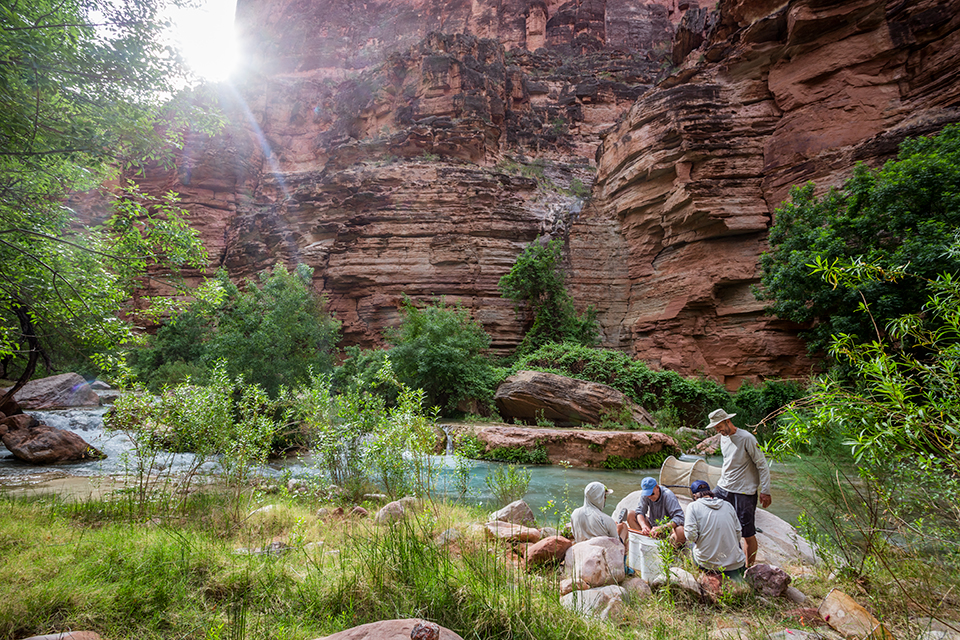
In general, though, doing what’s best for the humpback chub is likely to be at odds with optimum hydropower operations. The U.S. Bureau of Reclamation is currently drafting an environmental assessment of options to manage the smallmouth bass problem and is hoping to release the report for public comment by the end of 2023.
Another reason to be proactive is that fish removal programs are offensive to some Indigenous tribes connected to the Canyon. According to Kurt Dongoske, the historic preservation officer for the Pueblo of Zuni, aggressive management tactics that kill non-native fish in the Canyon cause harm to the Zuni people. He says the Canyon is the tribe’s place of origin and the aquatic species there are tied to the Zuni emergence story. The humpback chub and other fish, he says, are viewed as “Zuni children.” (Dongoske notes that he is not a member of the tribe but is charged with communicating Zuni values and concerns to government agencies.)
“From a Zuni perspective, improper treatment of sentient beings in the Zuni place of emergence has harmful ramifications for the community of Zuni,” he says. “The Western dominant culture wants to show preference for native species over non-native, but to the Zuni, all life forms should be respected. The sport fish that slip through the dam are just doing what fish do. They are not aware of boundaries decided by another species.”
The Pueblo of Zuni opposed the massive mechanical removal of rainbow trout that ventured from Lees Ferry into the Canyon. Now, pueblo leaders are asking federal agencies to avoid using such a strategy with smallmouth bass and instead manage Glen Canyon Dam so sport fish don’t escape in the first place.
While the record wet winter of 2023 raised Lake Powell and made it slightly more difficult for smallmouth bass to pass through the dam, Omana Smith says there’s no time to waste in coming up with a plan to head off disaster. More than 90 percent of the world’s remaining humpback chub live in the Canyon, but saving the species this time around will require actions that go well beyond Grand Canyon National Park. “There are hard societal conversations that need to happen,” Omana Smith says. “We need to acknowledge there is a problem and make really difficult decisions about water and power and food production.”
While the humpback chub may never be as plentiful as when Beamer lived in the Canyon, biologists have shown it is possible for the ancient fish to rule the Colorado once again. To get to that point will likely require people in the West to agree to conserve energy and water to reduce pressure on Colorado River reservoirs during drought. And there is much to be gained in return.
“To have a few spaces left where native species thrive is good for biodiversity and good for the balance of the ecosystem,” Martin says, “but it’s also good for the human spirit.”

